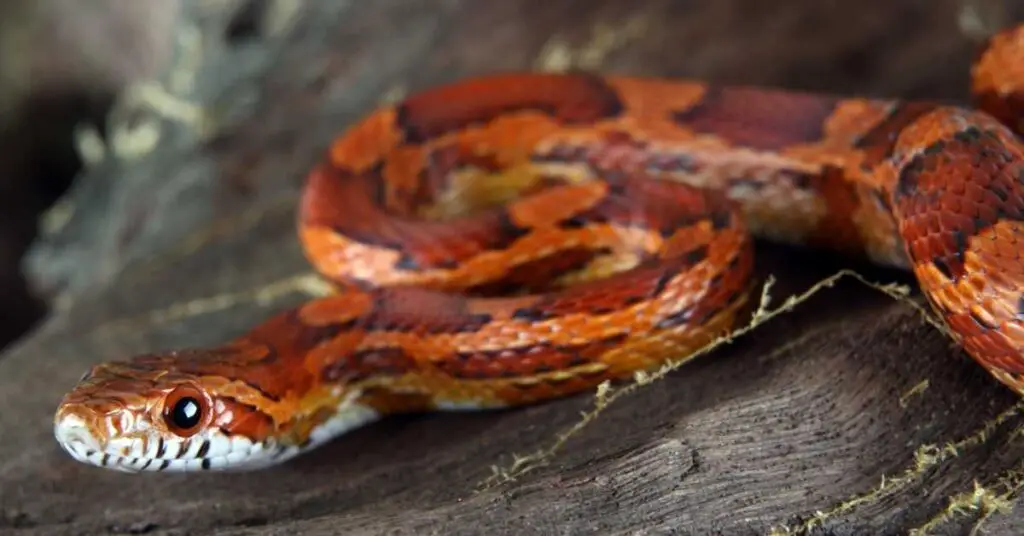You’ve probably wondered why corn snakes climb. Well, there are several reasons behind their climbing behavior that might surprise you.
From their natural habitat and instinctual behaviors to hunting techniques and seeking shelter, corn snakes have evolved to be skillful climbers.
But that’s not all – there’s more to uncover about these fascinating reptiles.
Key Takeaways
- Corn snakes have specialized adaptations for climbing, such as strong bodies, ventral scales for grip, and flexible bodies for coiling around objects.
- Climbing behavior is instinctual and deeply ingrained in their genetic makeup, enabling them to thrive in a variety of habitats.
- Ambush hunting and the ability to consume prey larger than their heads are key hunting techniques.
- Climbing provides shelter, safety, exercise, and access to higher vantage points for security.
Natural Habitat and Adaptations
Corn snakes, like many other reptiles, have evolved unique adaptations that allow them to thrive in their natural habitat. One of the evolutionary advantages that corn snakes possess is their climbing adaptations. These adaptations enable them to navigate and exploit their surroundings effectively.
Corn snakes have a specialized body structure that aids in their climbing abilities. They possess strong, muscular bodies and a slender shape, which allows them to move with ease through narrow crevices and branches. Additionally, they’ve long, flexible bodies that facilitate their ability to coil and wrap around objects for stability while climbing.
Their ventral scales, known as scutes, play a crucial role in their climbing adaptations. These scutes provide friction against surfaces, allowing them to grip onto tree trunks, branches, and other vertical structures. The scales have microscopic ridges that enhance their grip, preventing them from slipping and ensuring a secure hold as they ascend and descend.
Furthermore, corn snakes possess a specialized tongue that aids in their climbing adaptations. Their forked tongues are highly sensitive to chemical cues in their environment. This sensory ability helps them detect potential prey, predators, or suitable climbing paths, allowing them to make informed decisions while navigating their surroundings.

Instinctual Behaviors
With their specialized climbing adaptations, corn snakes exhibit a range of instinctual behaviors that enable them to navigate and interact with their environment in a precise and efficient manner. These behaviors are deeply ingrained in their genetic makeup and have been passed down through generations, allowing them to thrive in a variety of habitats.
Here are three key instinctual behaviors that play a vital role in the lives of corn snakes:
- Social interactions: Corn snakes, although generally solitary creatures, engage in social behaviors during breeding season. Males engage in elaborate courtship rituals, where they display vibrant colors and perform intricate movements to attract females. Once a pair has mated, the female will lay a clutch of eggs, and it isn’t uncommon for multiple females to lay their eggs in the same communal nest. This behavior ensures the survival of the species and allows for the exchange of genetic diversity.
- Defense mechanisms: When faced with potential threats, corn snakes employ several defense mechanisms to protect themselves. One such behavior is their ability to mimic rattlesnakes by vibrating their tails rapidly against dry leaves or grass, creating a rattling sound. This mimicry serves as a warning to potential predators, deterring them from attacking. Additionally, corn snakes are masters of camouflage. They can change their skin color to blend seamlessly with their surroundings, making it difficult for predators to spot them.
- Territorial behavior: Corn snakes exhibit territorial behavior, especially during the breeding season when they compete for mates. Males mark their territories with pheromones and engage in combat rituals to establish dominance. By defending their territories, corn snakes ensure their access to resources and increase their chances of successful breeding.
Understanding these instinctual behaviors allows us to appreciate the complexities of corn snakes and their ability to survive and thrive in their natural habitats. These behaviors not only serve important functions in their lives but also contribute to the overall ecological balance of their ecosystems.
Hunting and Feeding Techniques
To effectively hunt and feed, corn snakes employ a variety of specialized techniques and adaptations. One of their primary hunting strategies is ambush hunting. Corn snakes have a remarkable ability to remain motionless for extended periods, blending seamlessly into their surroundings. They patiently wait for unsuspecting prey, such as small rodents or birds, to come within striking distance. Once the prey is within range, the corn snake strikes with incredible speed, seizing it in its jaws.
A key adaptation that allows corn snakes to swallow large prey is their highly flexible lower jaw. Unlike humans, corn snakes have a unique jaw structure that allows them to open their mouths wide enough to engulf prey much larger than their own heads. Their jaws are connected by stretchy ligaments, enabling them to stretch their mouths to accommodate prey that may seem too large to swallow. This ability is crucial for their survival, as it allows them to consume a variety of prey sizes, ensuring they can meet their nutritional needs.
In addition to their remarkable jaw flexibility, corn snakes also have sharp, recurved teeth that aid in gripping and holding onto their prey. These teeth help prevent struggling prey from escaping and allow the snake to maintain a firm grip during the swallowing process.
Seeking Shelter and Safety
After successfully hunting and feeding, corn snakes prioritize seeking shelter and safety to protect themselves from potential predators and environmental hazards. Seeking shelter is a crucial instinct for corn snakes as it allows them to hide from predators and find a safe space to rest and conserve energy. Safety is also essential for their overall well-being as it helps prevent injuries and stress-related issues.
Here are three reasons why corn snakes exhibit climbing behavior in captivity:
- Climbing as a form of exercise: Corn snakes are natural climbers in the wild, and their captive counterparts still retain this instinct. Climbing provides them with physical exercise, promoting muscle development and overall fitness.
- Accessing higher vantage points: By climbing, corn snakes can reach higher areas in their enclosure, allowing them to survey their surroundings and feel secure. This behavior mimics their natural habitat where they’d seek elevated positions to observe potential threats.
- Finding hidden shelter: Corn snakes are adept at finding hidden spaces to seek shelter. By climbing, they can explore different levels of their enclosure, searching for suitable hiding spots such as tree branches, foliage, or rock crevices.
Understanding the reasons behind corn snakes’ climbing behavior in captivity is essential for providing them with a suitable environment that meets their natural instincts and promotes their well-being.
Environmental Enrichment and Exercise
Corn snakes benefit greatly from environmental enrichment and regular exercise to promote their physical and mental well-being. When kept in indoor captivity, it’s important to provide them with opportunities for behavioral stimulation. One way to achieve this is by creating a habitat that mimics their natural environment. Incorporating different types of climbing structures, such as branches and rocks, can encourage exercise and help simulate their instinctual behaviors. These structures should be securely placed to prevent any accidents or injuries. Additionally, providing hiding spots and different textures in their enclosure can also offer mental stimulation and encourage exploration.
Regular exercise is essential for corn snakes to maintain their overall health. Encouraging movement through the use of toys, tunnels, and interactive feeding methods can help simulate hunting behaviors. It’s important to provide enough space for the snake to move around comfortably, but also ensure that the enclosure isn’t too large, as this could cause stress. Regular handling and gentle interaction with the snake can also provide mental stimulation and promote trust.
Reproduction and Mating Strategies
Reproduction and mating in corn snakes involve a series of complex behaviors and strategies that ensure successful breeding and offspring production. These reptiles exhibit specific courtship rituals and follow distinct reproductive cycles to maximize their chances of successful reproduction.
Courtship rituals: Corn snakes engage in elaborate courtship displays to attract potential mates. Males will often engage in a behavior known as ‘tailing,’ where they follow the female closely, sometimes even intertwining their bodies. This behavior allows the male to assess the female’s receptivity and readiness to mate.
Reproductive cycles: Corn snakes are oviparous, meaning they lay eggs to reproduce. They follow a seasonal reproductive cycle, with breeding activity peaking during the spring and early summer. The female corn snake will release pheromones to signal her readiness to mate, attracting males in the vicinity. Once a male is successful in courtship, copulation occurs, leading to fertilization of the eggs.
Offspring production: After mating, the female corn snake will find a suitable location to lay her eggs. She’ll construct a nest by using her body to create a depression in the substrate. The female then deposits her eggs, which she’ll incubate for approximately 60 to 65 days until hatching occurs. The hatchlings are independent from birth and must fend for themselves.
Understanding the courtship rituals and reproductive cycles of corn snakes provides valuable insights into their mating strategies. These strategies play a vital role in the successful production of offspring and the survival of the species.
Frequently Asked Questions
What Is the Average Lifespan of a Corn Snake?
The average lifespan of a corn snake can vary depending on several factors. These factors include genetics, diet, habitat, and overall care. By providing a suitable environment and proper care, you can help maximize your corn snake’s lifespan.
How Do Corn Snakes Communicate With Each Other?
Corn snakes communicate with each other through social interactions and scent marking. They use chemicals called pheromones to leave messages for other snakes, indicating territory boundaries and potential mates.
Can Corn Snakes Recognize Their Owners?
Corn snakes have an incredible ability to recognize their owners, thanks to their impressive reptile intelligence levels. This is a result of their innate snake behavior patterns, such as using scent and visual cues to form connections.
Are Corn Snakes Venomous?
Corn snakes are not venomous. They climb to explore their surroundings and search for prey. In their diet, corn snakes primarily eat rodents. Temperature regulation is crucial for their survival, as they require specific temperatures to digest their food properly.
Do Corn Snakes Make Good Pets for Beginners?
As a beginner pet, corn snakes have both pros and cons. They are low-maintenance, docile, and can live up to 20 years. However, some misconceptions include their size and feeding habits.
Conclusion
In conclusion, corn snakes climb for various reasons related to their natural habitat and survival instincts.
Their ability to climb trees and shrubs allows them to hunt and feed on birds and eggs.
Climbing also helps them seek shelter and safety from predators on the ground.
Additionally, climbing provides environmental enrichment and exercise for these snakes, helping them maintain their physical and mental well-being.
Lastly, climbing plays a crucial role in their reproduction and mating strategies.
Overall, climbing is an essential behavior for corn snakes.


